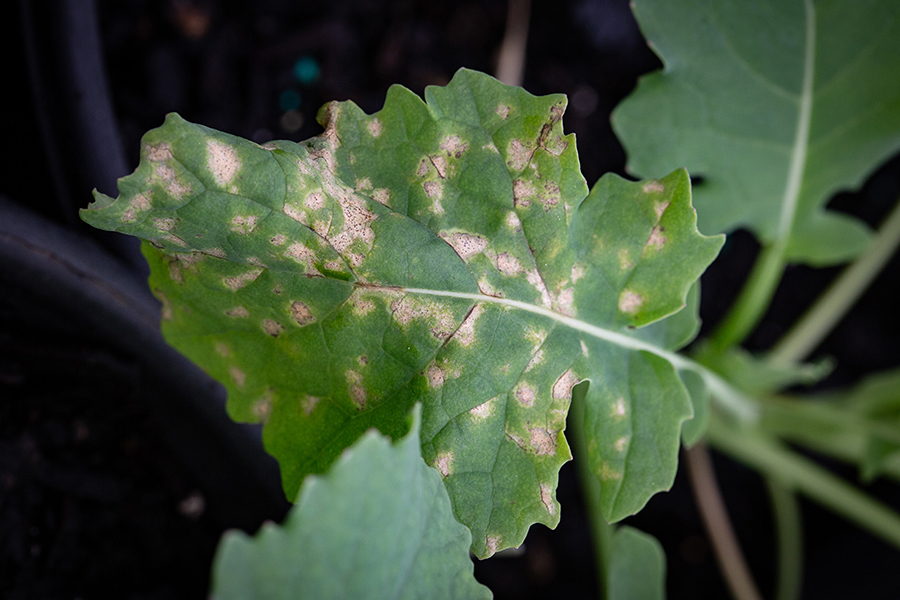A canola Blackleg management expert says sowing the crop in April and leaving old canola stubble standing are two factors that can increase the risk of upper canopy Blackleg infection.
Dr Steve Marcroft, of Marcroft Pathology, says sowing canola in April means crops flower from late July to early August, which puts plants in a high-risk period for upper canopy Blackleg infection.
“In the past, sowing canola during May would have resulted in leaf infection and crown cankers,” Dr Marcroft says. “But early April sowing means we are now seeing more branch and stem cankers in the upper canopy of canola crops.”

Blackleg lesions on a canola leaf. Photo: Thea Jane Photography
Blackleg is now occurring later in the season, which is affecting the flowers, with the amount of damage driven by the intensity of canola production and the amount of rainfall during the growing season, he says.
“The more canola produced within an area means more stubble, which leads to more inoculum and the harder it is to plant new canola crops away from old canola stubble,” he says.
“Our first recommendation is to keep a 500-metre buffer and that’s possible for a lot of regions in Australia, but in intensive canola production areas nobody does that anymore.”
Seed treatment
Dr Marcroft says seed treatments are effective for protecting against Blackleg crown canker, but they do not have longevity to protect plants against upper canopy Blackleg infection.
Seed treatments do not provide complete control, so they are best used in conjunction with genetic resistance, he says.
For instance, growers who plant moderately susceptible to moderately resistant cultivars protected with a seed treatment or fungicide amended fertiliser – when grown under high blackleg severity conditions – are likely to see a significant reduction in disease severity.
“Growers who plant canola varieties with inadequate resistance, for example moderately susceptible to susceptible, will see a response to the seed treatment but crops may still have significant damage from Blackleg. Growers who sow cultivars rated highly for resistance, such as moderately resistant to resistant, will generally not see a response to seed treatment.”
Decision support
Dr Marcroft says the BlacklegCM app, available for download to Android and Apple tablet devices, can help determine the economic return for various Blackleg fungicide management strategies.
“If you’re sowing a canola variety that is highly resistant to Blackleg that has a seed treatment applied, it’s likely there will be no economic return from applying a fungicide at the four to eight-leaf stage. But if you’re sowing a more susceptible cultivar right next to last year’s canola stubble, then you really need to do everything you can to protect your crop in a district with a lot of canola.”
To those sowing canola crops early, he says crops are likely to flower early, which means they are more vulnerable to upper canopy infection from Blackleg. Nonetheless, sowing early means the severity of the traditional Blackleg crown canker is likely to be reduced at earlier growth stages.
“The crown canker is caused by seedling infection and if you sowed the crop at the end of May, the canola seedlings would germinate and sit there for the whole of winter as small seedlings getting blasted by Blackleg spores, which would produce lots of crown canker.
“If you are sowing in April, the canola plants emerge in warm soil, grow quickly and move beyond the third leaf stage before the onset of winter, which results in stronger, more robust seedlings and much less Blackleg crown canker.”
This would mean there is less likely to be an economic return from foliar application at the four to eight-leaf stage.
Standing stubble
Dr Kurt Lindbeck, a senior plant pathologist at the NSW Department of Primary Industries, says leaving canola stubble standing is one factor that increases the risk of upper canopy Blackleg infection in canola crops.
“Traditional Blackleg is the infection that occurs at the seedling stage, which expresses itself as dry stem canker or dry rot at the base of the canola during spring,” Dr Lindbeck says.

NSW Department of Primary Industries senior plant pathologist Dr Kurt Lindbeck looking at disease experiments at the Wagga Wagga Agricultural Institute. Photo: Nicole Baxter
“But what we’re seeing is upper canopy infection, where Blackleg lesions develop on the stem later in the growing season as plants are branching and forming pods.”
He says these later Blackleg infections result from a combination of factors that include tighter canola/wheat rotations, earlier sowing and – importantly – leaving old canola stubble standing.
Research findings
Dr Marcroft says recent research shows stubble that remains standing stays dry, does not develop fruiting bodies at the same rate as prostrate stubble and, therefore, releases spores later in the growing season.
“We think delayed spore release in the growing season may result in increased upper canopy Blackleg infection because the reproductive parts of the plant are directly infected, rather than the seedlings and leaves,” he says.
“Experiments in Horsham, Victoria, during 2019 showed stubble that was standing in year one and lying flat on the ground in year two released fewer spores in the first half of the growing season, but the proportion of released spores in the second half of the growing season increased.”
Dr Lindbeck says one of the steps that can be taken to reduce the risk of upper canopy infection is to accelerate the rate of canola stubble decomposition by incorporating stubble into the soil using either a Speedtiller® or scarifier.
“Even just knocking down the stubble with a set of harrows to smash up the remaining standing canola residue will increase the amount of stubble-soil contact and increase the rate of stubble breakdown. This will likely result in Blackleg spores being released earlier in the season,” he says.
Flowering onset
Dr Marcroft says there is a strong relationship between the earlier onset of flowering and grain yield loss caused by upper canopy Blackleg infection.
“Plants that start to flower early in the growing season are more likely to be infected as they will flower under cooler and wetter conditions, which are conducive for lesion development,” he says.
“However, it is now also known that plants infected earlier in the growing season have more time for the fungus to damage the vascular tissue before plant maturity and harvest.”
He says canola plants are particularly susceptible to stress during the early stages of flowering.
“Evidence from controlled-environment and field experiments indicates that plants infected by Blackleg on the upper main stems and branches during early flowering results in the greatest reduction of grain yield compared to crops that flower later or are infected at later growth stages,” he says.
“Yield loss can be due to reduced seed size, seeds per pod and/or pods per square metre. Oil content can also be reduced. By delaying the start of canola flowering, growers may be able to avoid severe upper canopy Blackleg infections.”
Blackleg resistance
Dr Marcroft says a canola variety with effective major gene resistance will not suffer any upper canopy Blackleg infection. “Nonetheless, it is difficult to determine if the variety has effective major gene resistance because it depends on the Blackleg population on your farm,” he says.
“The best way to determine major gene resistance is to monitor crops for leaf lesions. Major gene resistance is effective across all plant parts, so if there are no leaf lesions it means there could be no Blackleg present or, more likely, that your cultivar has effective major gene resistance.”
Another form of resistance is cultivar quantitative resistance, which is indicated by the Blackleg rating of the variety, he says. “Canola varieties can have a high Blackleg resistance rating from a major gene, but low quantitative resistance. If the variety has a resistant rating, it should either have effective major gene or excellent quantitative resistance.
“We know that cultivars with good quantitative resistance show upper canopy infection symptoms, but we think these cultivars may suffer less damage to the vascular tissue than more-susceptible cultivars.”
He says this may be similar to how cultivars react at the seedling stage, whereby a moderately resistant cultivar and a moderately susceptible cultivar both show leaf lesions, but the moderately susceptible variety develops more crown canker and suffers more grain yield losses.
“The reality is that we need to develop a robust Blackleg rating system for upper canopy infection,” he says. “We are working on it.”
Fungicide management
Blackleg upper canopy infection refers to infection of the upper stem, branches, flowers and pods. While understanding of these new symptoms is constantly improving, Dr Marcroft says, there is still a very large knowledge gap of how individual canola varieties react to upper canopy infection.
“Our research shows that similar symptoms of upper canopy infection can cause very severe economic impacts in one season and no economic impacts in another,” he says.
“As such, our recommendations for managing Blackleg upper canopy infection are constantly evolving.”
 Blackleg upper canopy infection can affect flowers but also the upper stem, branches and pods. Photo: Thea Jane Photography
Blackleg upper canopy infection can affect flowers but also the upper stem, branches and pods. Photo: Thea Jane Photography
Dr Marcroft says the fungicides used to control Sclerotina have also been shown to reduce upper canopy Blackleg infection severity and grain yield losses.
“Application of Prosaro® or Aviator® Xpro for Sclerotinia control around 30 per cent bloom can also provide protection from Blackleg infection during early flowering,” he says.
“The 30 per cent bloom spray may control flower, peduncle, stem and branch infections, but is unlikely to provide pod infection.”
He says there are no control options for pod infection, which tends to occur in seasons with frequent late rainfall events or where there is physical damage to the pods from hail.
Rules of thumb
If Blackleg lesions can be seen on the upper leaves of canola during the first week of August and the crop is just coming into flower with high yield potential, Dr Marcroft says the probability of seeing an economic response from applying a Sclerotinia spray at 30 per cent bloom to manage upper canopy Blackleg infection is increased.
“If no Blackleg lesions are on the upper leaves of canola during the first week of August, then the probability of seeing an economic response from applying a Sclerotinia spray at 30 per cent bloom to manage upper canopy Blackleg infection is a lot less,” he says.
“Growing a canola variety with a higher Blackleg rating may result in reduced damage from upper canopy infection, but this is very preliminary work and more in-depth studies are required to confirm this.”
Wet versus dry finish
Work undertaken by Dr Susie Sprague at CSIRO has shown in a cool, wet season, canola plants can tolerate partial blockage of the vascular tissue and not suffer so much grain yield loss. By contrast, in a hot and dry finish, the same amount of damage can cause more grain yield losses.
“But, in a drier finish, less Blackleg is likely to be about to cause damage to canola crops,” Dr Marcroft says. “In a wet season, there is likely to be more damage.”
Accordingly, in drier finishes, he says there is less likely to be an economic benefit from applying a fungicide later in the season to protect against upper canopy Blackleg infection.
More information: Steve Marcroft, 0409 987 941, steve@grainspathology.com.au; Kurt Lindbeck, 02 6938 1608, kurt.lindbeck@dpi.nsw.gov.au

























































